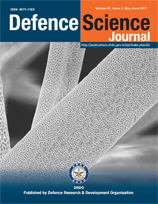Integrating Non-linear and Linear Diffusion Techniques to Prevent Fault Attacks in Advanced Encryption Standard to Enhance Security of 4G-LTE Networks
DOI:
https://doi.org/10.14429/dsj.67.10118Keywords:
Long term evolution, Fault attack, Diffusion technique, Advanced encryption standardAbstract
Long term evolution based fourth generation (4G) mobile technology has provided a platform for fast and efficient wireless communication. The advanced encryption standard (AES) is one of the three cryptographic algorithms used in 4G networks for encryption of sensitive data. In spite of offering high immunity, AES is still vulnerable to few attacks. This weakness in AES algorithm makes 4G susceptible to several security issues. This paper specifically focuses on fault attacks performed on AES. A fault induced in any one of the rounds of AES helps the attacker to derive information about the secret key. In this manner, these fault attacks pose a serious threat to wireless mobile communication as he or she may gain access to any network that is encrypted with AES. In earlier works, various countermeasures have been suggested to prevent them. However, each of these preventive measures has their own limitations and vulnerabilities. This paper proposes an enhanced method of preventing fault attacks in AES by incorporating a combination of non-linear and linear diffusion techniques. This method identifies if a fault has been injected and diffuses the fault well into the matrix, providing no information about the secret key to the attacker. The performance evaluation proves that the proposed prevention method outperforms the others in terms of time, cost and efficiency.Downloads
Published
2017-04-25
How to Cite
Mathi, S. kumar, Kalyaan, P., S., K., & S., B. (2017). Integrating Non-linear and Linear Diffusion Techniques to Prevent Fault Attacks in Advanced Encryption Standard to Enhance Security of 4G-LTE Networks. Defence Science Journal, 67(3), 276–281. https://doi.org/10.14429/dsj.67.10118
Issue
Section
Computers & Systems Studies
License
 Where otherwise noted, the Articles on this site are licensed under Creative Commons License: CC Attribution-Noncommercial-No Derivative Works 2.5 India
Where otherwise noted, the Articles on this site are licensed under Creative Commons License: CC Attribution-Noncommercial-No Derivative Works 2.5 India


